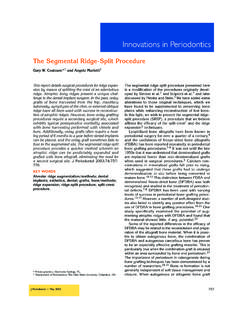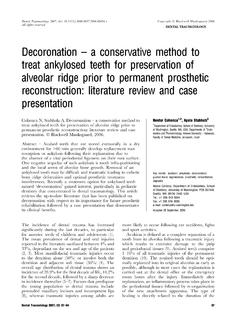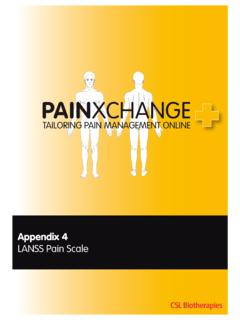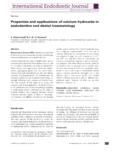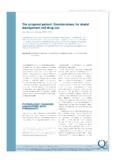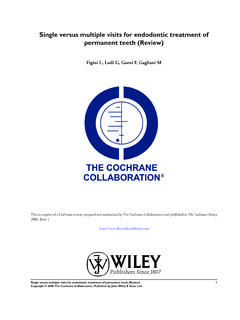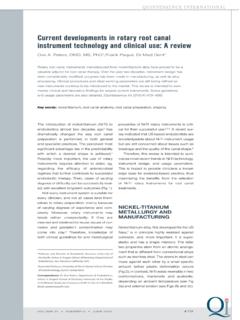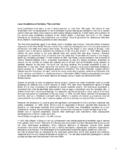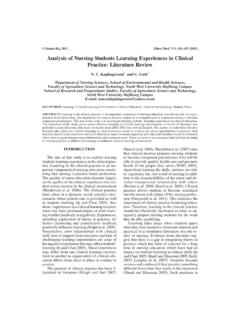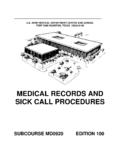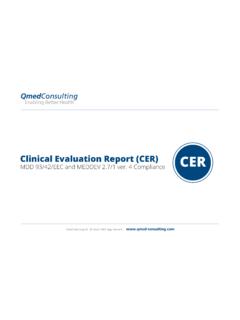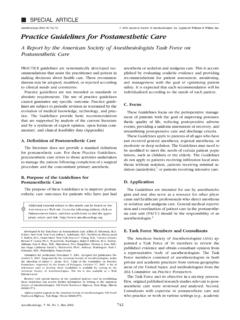Transcription of Nonvital Tooth Bleaching: A Review of the …
1 Nonvital Tooth bleaching : A Review of the literature andClinical ProceduresGianluca Plotino, DDS,* Laura Buono, DDS,* Nicola M. Grande, DDS,*Cornelis H. Pameijer, DMD, DSc, PhD, and Francesco Somma, MD, DDS*AbstractTooth discoloration varies in etiology, appearance, lo-calization, severity, and adhesion to Tooth structure. Itcan be defined as being extrinsic or intrinsic on thebasis of localization and etiology. In this Review of theliterature, various causes of Tooth discoloration, differ-ent bleaching materials, and their applications to end-odontically treated teeth have been described. In thewalking bleach technique the root filling should becompleted first, and a cervical seal must be bleaching agent should be changed every 3 7 thermocatalytic technique involves placement of ableaching agent in the pulp chamber followed by heatapplication.
2 At the end of each visit the bleaching agentis left in the Tooth so that it can function as a walkingbleach until the next visit. External bleaching of end-odontically treated teeth with an in-office techniquerequires a high concentration gel. It might be a sup-plement to the walking bleach technique, if the resultsare not satisfactory after 3 4 visits. These treatmentsrequire a bonded temporary filling or a bonded resincomposite to seal the access cavity. There is a defi-ciency of evidence-based science in the literature thataddresses the prognosis of bleached Nonvital , it is important to always be aware of thepossible complications and risks that are associatedwith the different bleaching techniques. (J Endod 2008;34:394 407)Key WordsBleaching, discoloration, in-office bleaching , root filledteeth, thermocatalytic technique, walking bleach tech-niqueHistory of bleaching TeethReports on bleaching discolored Nonvital teeth were first described during themiddle of the 19th century (1), advocating different chemical agents (2).
3 Initially,chlorinated lime was recommended (3), followed later by oxalic acid (4, 5) and agentssuch as chlorine compounds and solutions (6 8), sodium peroxide (9), sodiumhypochlorite (10), or mixtures consisting of 25% hydrogen peroxide in 75% ether(pyrozone) (11, 12). An early description (1884) of the use of hydrogen peroxide wasreported by Harlan (13). Superoxol (30% hydrogen peroxide) had been mentioned byAbbot (14) in 1918. Prinz (15) in 1924 recommended using heated solutions consist-ing of sodium perborate and Superoxol for cleaning the pulp cavity. Some authorsproposed using light (16, 17), heat (16, 18, 19 22), or electric currents (23, 24) toaccelerate the bleaching reaction by activating the bleaching perborate in the form of monohydrate, trihydrate, or tetrahydrate is usedas a hydrogen peroxide releasing agent.
4 It has been used since 1907 as an oxidizer andbleaching agent, especially in washing powder and other detergents. The whiteningefficacy of sodium perborate monohydrate, trihydrate, or tetrahydrate mixtures witheither water or hydrogen peroxide is not different (25).Causes of Tooth DiscolorationThe correct diagnosis of the cause of discoloration of teeth is of great importancebecause it has a profound effect on the treatment outcome. It is therefore necessary thatdental practitioners have an understanding of the etiology of Tooth discoloration toarrive at a correct diagnosis leading to an appropriate treatment plan (26). Tooth color is determined by a combination of phenomena associated with opticalproperties and light (27).
5 Essentially, Tooth color is determined by the color of dentin(28) and by intrinsic and extrinsic colorations (26). Intrinsic color is determined bythe optical properties of enamel and dentin and their interaction with light (28). Ex-trinsic color depends on material absorption on the enamel surface (29). Any changein enamel, dentin, or coronal pulp structure can cause a change of the light-transmittingproperties of the Tooth (30). Tooth discoloration varies in etiology, appearance, location, severity, and affinityto Tooth structure (31). It can be classified as intrinsic, extrinsic, or a combination ofboth, according to its location and etiology (32).Extrinsic CausesThe principal causes are chromogens derived from habitual intake of dietarysources, such as wine, coffee, tea, carrots, oranges, licorice, chocolate, or from to-bacco, mouth rinses, or plaque on the Tooth surface (26, 32).
6 Intrinsic CausesSystemic causes are 1) drug-related (tetracycline); 2) metabolic: dystrophic cal-cification, fluorosis; and 3) genetic: congenital erythropoietic porphyria, cystic fibrosisof the pancreas, hyperbilirubinemia, amelogenesis imperfecta, and dentinogenesis causes are 1) pulp necrosis, 2) intrapulpal hemorrhage, 3) pulp tissueremnants after endodontic therapy, 4) endodontic materials, 5) coronal filling mate-rials, 6) root resorption, and 7) the *Department of Endodontics, Catholic Universityof Sacred Heart, Rome, Italy; and Professor Emeritus, Schoolof Dental Medicine, University of Connecticut, Farmington, requests for reprints to Gianluca Plotino, DDS, ViaEleonora Duse, 22, 00197 Rome, Italy. E-mail - see front matterCopyright 2008 by the American Association Article394 Plotino et Volume 34, Number 4, April 2008 Extrinsic stain is found on the Tooth surface and for this reason canbe removed with relative ease.
7 Affinity of materials to the Tooth surfaceplays a critical role in the deposition of extrinsic stain. The types ofattractive forces include long-range interactions such as electrostaticand van der Waals forces and short-range interactions such as hydrationforces, hydrophobic interactions, dipole-dipole forces, and hydrogenbonds(33). These interactive forces allow the chromogens to get closeto the Tooth surface and determine whether adhesion will occur. Theaffinity of chromogen adhesion varies with the material, and the mech-anisms that determine the strength of adhesion are not clearly under-stood(34). For example, clinical evidence has shown that tea and coffeestains become more difficult to remove with aging(34).In the past, extrinsic Tooth discoloration has been classified asmetallic or nonmetallic stain(35).
8 There are several problems with thisclassification. First, it does not explain the mechanism of discoloration;second, the extent of staining is variable and might depend on multiplefactors; third, all metals do not cause extrinsic discoloration. To over-come these problems, a new classification based on the chemistry ofdental discoloration has been proposed(34).The most commonly used procedure toremove discoloration froma Tooth surface is by using abrasives (such as prophylactic pastes)(31)ora combination of abrasive and surface active agents such as toothpastes(36). These methods prevent stain accumulation and to a certain extentremove extrinsic stains(34); however, satisfactory stain removal dependson the type of discoloration(36). Unfortunately, the chemical interactionsthat determine the affinity of different types of materials that cause extrinsicdental stains are not well-understood(34).
9 Unlike extrinsic discolorations that occur on the surface, intrinsicdiscoloration is due to the presence of chromogenic material withinenamel or dentin, incorporated either during odontogenesis or aftereruption(31). This type of stain can be divided into 2 groups, pre-eruptive and posteruptive(31, 34). The most common type ofpre-eruptive staining is endemic fluorosis caused by excessive fluorideingestion during Tooth development. A method for removal of dentalfluorosis stains, on the basis of the structural characteristics of thefluorotic Tooth , has been reported to be effective(37). It encompassed3 principal stages: enamel etching with 12% hydrochloric acid, appli-cation of pure sodium hypochlorite, and filling the chemically openedmicroporosities with a light-cured dental adhesive. Staining caused bytetracycline administration also occurs during odontogenesis and is aresult of antibiotic interactions with hydroxyapatite crystals during themineralization phase.
10 Malformation of dental tissues occurring as aresult of inherited conditions such as dentinogenesis imperfecta andamelogenesis imperfecta can also cause pre-eruptive dental stain. He-matologic disorders such as erythroblastosis fetalis, thalassemia, andsickle cell anemia might also cause pre-eruptive stain because of thepresence of coagulated blood within the dentinal events that influence Tooth formation can represent an-other cause of pre-eruptive discoloration(31). Teeth might acquireposteruptive intrinsic stains in a similar way. Normal aging can alsocause posteruptive dental stain caused by the deposition of secondarydentin, tertiary dentin, and pulp stones(38). It has also been reportedthat dental procedures might lead to Tooth discoloration, owing to re-lease of metals from, for instance, amalgam restorations or incompleteobturation of the pulp chamber after endodontic treatment(34).
